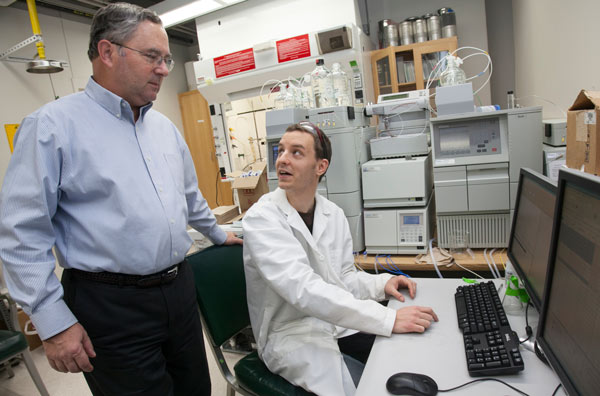
UW-Madison Professor of Chemical and Biological Engineering James Dumesic (left) checks on an experiment with postdoctoral fellow Jeremy Luterbacher (right). Dumesic’s lab leads research on the catalytic conversion of cellulosic biomass to fuels and chemicals.
Depending on the configuration, a Tinkertoy piece can either result in a connection or a dead end. In the realm of biofuels, these pieces take the form of chemical compounds like furfural and levulinic acid (LA), which can stifle or strengthen fuel production.
At the GLBRC, James Dumesic is working to leverage furfural and LA, which are known inhibitors of biomass fermentation to ethanol. Using a technique called heterogeneous catalysis, Dumesic and his team can turn these compounds into platform chemicals—molecular springboards for manufacturing useful products ranging from footwear to fuel.
“Fermentation-wise, you don’t want the furfural and LA,” says Dumesic, a professor in the UW–Madison College of Engineering. “But we take these fermentation inhibitors and we try to make as much of them as we can. Then, we convert them to other [materials].”
Platform chemicals form the basis of compounds found at home and in industry, including resins, paints, sporting equipment, detergents, cosmetics, and pharmaceuticals. Scientists can also use these compounds to generate fuels like gasoline and diesel.
“The concept that we follow is to convert sugars first into platform molecules,” says Dumesic. “On the other hand, if you want a fuel, then these platform molecules can be processed further into hydrocarbons.”
Hydrocarbons derived from platform molecules can be readily ‘dropped in’ to the same fuel infrastructure currently used to power today’s busy world of travel and trade. Drop-in fuels produced by Dumesic’s team could be mixed with gasoline for the daily highway commute, while others are better suited for use in heavy transportation systems like airplanes.
In addition to their versatility, these platform chemicals are also renewable because they are derived from plants. That means they could provide more sustainable alternatives to some petroleum-based materials as global fossil fuel supplies continue to dwindle.
While the renewable properties of these platform chemicals can provide an environmental advantage, cost-effectiveness must be achieved before that advantage can be realized.
Zachary Ellis, a licensing associate with the Wisconsin Alumni Research Foundation (WARF), sees potential for the industrial application of biomass-derived chemicals and fuels. In a WARF-coordinated market analysis, Ellis found that furfural and LA have high market values. The key to industry, he says, now depends on developing processing reactions that hit a commercial sweet spot: they must produce fuels and intermediate chemicals on a large scale for a low cost that will appeal to manufacturers.
“Professor Dumesic is a thought leader in the field of deriving chemicals from biomass—he has pretty much defined a lot of the intellectual property landscape himself,” says Ellis. “Now, the challenge is to produce large quantities of these chemicals at a competitive price.”
For manufacturers, adopting biomass-derived chemicals and fuels means that the price of renewables must be low enough to make the transition affordable. The expenses associated with such a transition are referred to as ‘switching costs.’
“If you go from using an iPhone to using a Droid, assuming the phones are the same price, then the cost to switch might include having to buy a new phone charger and new cases,” explains Ellis. “In order for Dumesic’s technologies to be attractive, he has to make his products a certain percentage cheaper to justify the switching costs.”
Fortunately, because drop-in fuels by definition do not require a significant amount of new infrastructure, the switching costs associated with them are relatively low. Dumesic has been able to distill biofuels generated from catalytic reactions using an approach that mirrors energy production from fossil fuels, and which could be integrated into current refinery models.
With WARF’s guidance, Dumesic and his team are now focusing on producing drop-in fuels as efficiently and economically as possible with an eye toward industry. A top priority is identifying the specific biofuel feedstocks that are best suited to heterogeneous catalysis reactions.
“In technoeconomic analyses of our processes, the major factor that determined the cost of our fuel was the cost of the biomass,” says Dumesic. “Something that GLBRC is in a position to give leadership on is life cycle analysis of feedstocks and the quantities that would be sustainably produced and at what price.”
One of the benefits of heterogeneous catalysis is that it can be successfully used on many different types of biomass. Currently, GLBRC-produced corn stover—a term for the leaves and stalks of corn plants—is the primary feedstock used in Dumesic’s labs. However, he says that others could work just as well depending on their availability.
“If the GLBRC, through their analyses, decided that one feedstock was a better energy source in a particular geographic location, our approach can be easily tailored to that,” he says. “I think that’s an area where being part of the GLBRC is very valuable for us.”
While much remains to be learned about drop-in fuels and the markets for them, the Dumesic group’s work highlights the diversity of approach that is a hallmark of GLBRC research. Going forward, the Center hopes that a combination of technological innovation and commercial development will help position renewable compounds for use as building blocks in a variety of known fuels and products, as well as others that have yet to be discovered.